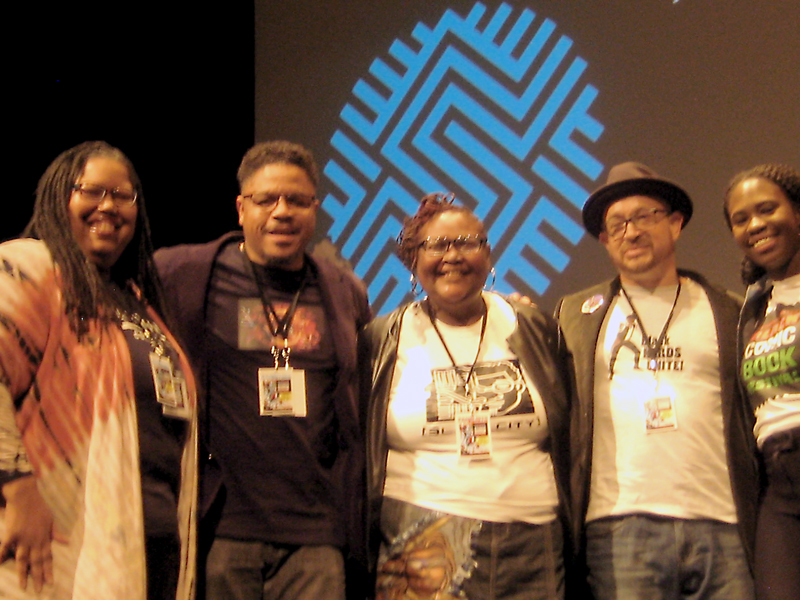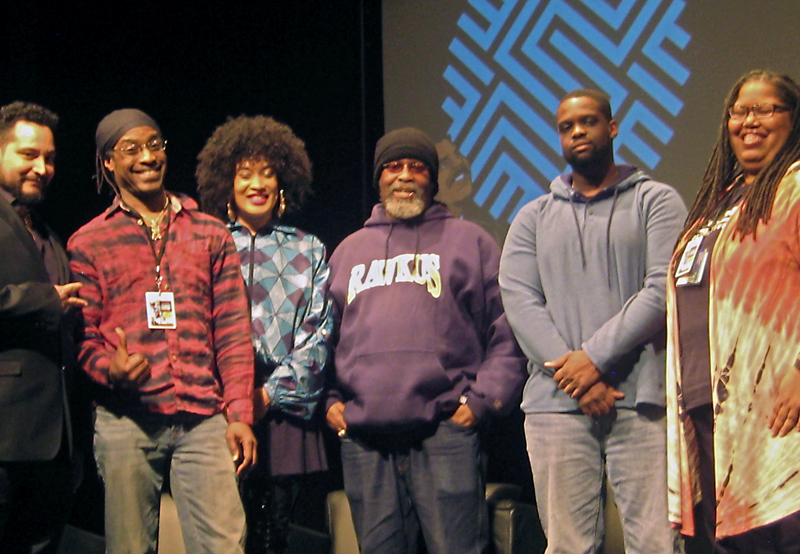Celebrating Culture Through Comics | 2019 Schomburg Center Black Comic Book Festival
On January 18–19, more than 10,000 comics fans, creators, publishers, and community members gathered for the Seventh Annual Black Comic Book Festival (BCBF) at the New York Public Library’s Schomburg Center for Research in Black Culture in Harlem.
On January 18–19, more than 10,000 comics fans, creators, publishers, and community members gathered for the Seventh Annual Black Comic Book Festival (BCBF) at the New York Public Library’s Schomburg Center for Research in Black Culture in Harlem. The event featured author signings, youth programming, fan-favorite cosplay, and more than 50 exhibitors representing small and independent presses and self-published creators. Panel discussions spanned topics such as “ AfroPuertorriqueños: Cultural & Social Activism in Comics ” and “#FortheCulture: New York City in Comics ” to “How To Launch Your Comic Kickstarter” and “Scripting Our Stories: Black Women Writers in Comics.”
Wrapping up Friday afternoon’s schedule were two well-attended programs held in the center’s Langston Hughes Auditorium. “Curating Black Nerdy Spaces,” moderated by the Schomburg’s manager of education programs and outreach Kadiatou Tubman, addressed why now is the time for building diverse spaces that, through the comics medium, foster discovery, connection, creativity, and conversation. Comic con founders and panel speakers Cagen Luse (#ComicsinColor), Clairesa Clay (BlerdCity Con), Hilton George (Blerdcon), and Deirdre Hollman (Black Comics Collective) led things off, revealing that aha! moment that set their work into motion. Each then explored the impact of that work today and ways to keep the momentum going.
 |
(l.–r.) Deirdre Hollman, Hilton George, Clairesa Clay, Cagen Luse, and Kadiatou Tubman (moderator) |
For Luse, the journey began years ago at the Schomburg festival, when he first noticed a significant paradigm shift, or “Black Panther effect,” which saw more people of color becoming interested in comics, spurring him to start a similar event in his own community in Boston. Brooklynite Clay established the Brooklyn-based BlerdCity Con, now in its third year, after research on Afrofuturism led her to discover the word blerd (black nerd), a term she felt described her perfectly in her most natural state, thus envisioning a space that embodied this way of being. Lifelong cosplayer George, having found every convention and nerd space he’d attended lacking in representation of work by and for people of color, set out to make this the “main thing on the menu.” He developed Blerdcon in Washington, DC, also in its third year. The spark for educator and Harlemite Hollman came through observing a growing curiosity among young people about manga and comics and wanting to be sure they knew there were people of color creating comics that reflected their experience. Hollman combined forces with cartoonist Jerry Craft, scholar Jonathan Gayles, and creator John Jennings to cofound the first BCBF.
For the evening’s final panel, “#FortheCulture: New York City in Comics,” the charismatic Hollman transitioned from speaker to moderator, introducing writers and artists with stories set against the backdrop of New York City’s five boroughs. Representing Harlem and uptown was N. Steven Harris (Ajala; Watson and Holmes); the Bronx, Ray Felix (“Bronx Heroes” series) and Mikaila Brown (The Boogie Down Brigade ); the “original” Brooklyn, Andre LeRoy Davis (The Last Word); and for Queens and all-city New York, Stephane Metayer (Tephlon Funk).
 |
(l.-r.) Ray Felix, N. Steven Harris, Mikaila Brown, Andre LeRoy Davis, Stephane Metayer, and Deirdre Hollman (moderator) |
So why New York City, posed Hollman. For fashion anthropologist Brown it’s all about giving back and telling the true stories of real-life people. With Boogie Down Brigade, Brown chronicles the history of fashion in the Bronx from the 1960s to the present, aiming to expose more readers to the richness of the borough's vibrant culture. The Bronx, exclaimed Felix, harking back to the early 2000s TV drama, is not burning! Traditions such as salsa dancing, fashion, comic books, and jazz all come out of the Bronx, so why don’t people associate it with any of that good stuff, he asked. His series “Bronx Heroes” attempts to do just that through tales of ordinary people living, surviving, thriving, and often performing heroic deeds.
Deeply immersed in the world of hip-hop, Brooklyn native Davis cites the flavor of his art as cocky and authentically New York. Whether illustrating a DJ from Harlem, the Bronx, or Brooklyn, he’s also interested in showing the superheroic actions of regular people. Most important is that the work symbolizes where you’re from, he said. Removing the stigma attached to youth living in housing projects is the aim of Metayer’s Tephlon Funk, which features a teenaged girl from Queensbridge in the 1990s and draws inspiration from hip-hop and manga. Similarly, artist Harris’s Harlem-set Ajala, cocreated with writer Robert Garrett, focuses on the titular teen who discovers her family’s long history with a secret organization working to protect the community and seeks to become an agent herself. Central to the story, said Harris, are the social justice themes of bullying, police brutality, gentrification, history, and culture.
Capping off the festival was the popular panel “Scripting Our Stories: Black Women Writers in Comics," which highlighted new work by some of comics’ most talented up-and-coming female creators. The discussion was moderated by SYFY Wire contributing editor Karama Horne (theblerdgurl.com) and featured Vita Ayala (The Wilds; Livewire; Submerged), who got their start in 2016 at DC Comics but saw their career take off with the release of the queer zombie stories The Wilds (Black Mask); Regine Sawyer (The Rippers; Eating Vampires), owner/writer/creator of Lock It Down Productions and coordinator/founder of the Women in Comics NYC Collective International; Jamila Rowser (with artist Robyn Smith, Wash Day), founder of Black Josei Press; and the award-winning writing team of twin sisters Shawnee and Shawnelle Gibbs (The Invention of E.J. Whitaker), who said by way of introduction that they were raised on the language of drawing and selling comics before “we even had a language.”
 |
(l.-r) Karama Horne (moderator), Vita Ayala, Regine Sawyer, Jamila Rowser, Shawnee Gibbs, and Shawnelle Gibbs |
The creators' artistic influences ranged from slice-of-life tales and Wonder Woman to newspaper strips such as Cathy, Gasoline Alley, and Archie, as well as inspiring family members. Rowser noted comics about adult women and manga as especially significant to her creative development. Remarking on the differences between including a black female, femme, or LGBTQ character and writing one from experience, Horne asked the panelists to discuss how their voices make their comics unique. Several said they draw on the interactions of friends and family to show the experience among people of color in authentic ways. Sawyer reflected that readers will see in her work how “hard I fight, both for myself and my [community] members.” Ayala prefers to incorporate various viewpoints and tends to portray their own struggle on the page, mostly through brown and queer characters because they are the people with whom the cartoonist identifies as a black Puerto Rican. Shawnee Gibbs recalled enjoying the “amazing adventures of white boys,” namely films by Steven Spielberg, interjecting herself into the story, wanting to enjoy it. The Gibbses’ Invention of E.J. Whitaker, a steampunk tale set in the early 1900s starring black women in Victorian-era pieces, opens up a world in which black stories have previously been unexplored. “The women’s struggles aren’t antiquated,” said Shawnee Gibbs. “We’re still negotiating for ourselves today.”
In response to Horne’s question of how one writes for “the other,” Sawyer asserted, “it’s all about resonating with another human being. She recommended doing one’s research, talking to people outside of one’s race, and speaking to a queer person. Reemphasizing these points, Ayala encouraged the audience to "practice putting yourself in others’ shoes, research but also respect. You can write about people who are different from you, but talk to people....”
The conversation drew to a close with Horne asking how social media informed each panelist’s work. While this didn’t apply to Rowser’s experience, the writer still took the opportunity to stress that as a black Latina woman, she could speak to her own experience and that of her friends, but that she doesn't “speak for all black Latina women.”
Also check out these highly recommended comics resources: Geek Girl Brunch, Ladies Night Anthology, and CartoonistsOfColor.com.

RELATED
ALREADY A SUBSCRIBER? LOG IN
We are currently offering this content for free. Sign up now to activate your personal profile, where you can save articles for future viewing









Add Comment :-
Comment Policy:
Comment should not be empty !!!